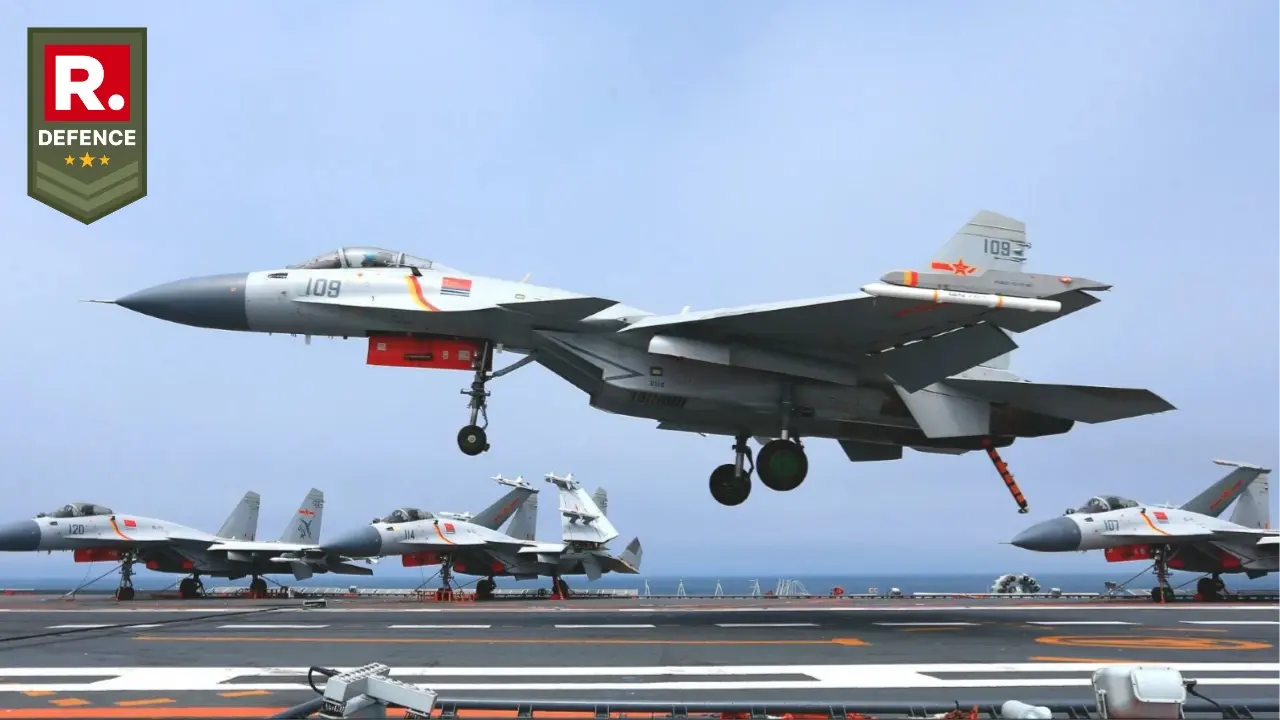Updated 24 March 2025 at 16:34 IST
Chinese J-15 Fighter Crash ‘Exposes’ PLA’s Carrier Woes; Beijing’s Naval Ambitions Face Reality Check
While Chinese state media remains tight-lipped on the cause, this incident adds to a growing list of failures plaguing Beijing’s ambitions for air supremacy.
- Defence News
- 4 min read

Beijing, China – Beijing’s dreams of ruling the seas with its homegrown carrier-based J-15 fighter jet took another hit when one of the aircraft went down during a training exercise in Hainan Province. The crash, which happened on March 15 near Jialai Town in Lingao County, forced the pilot to eject—but thankfully, he survived. While China’s state media is staying tight-lipped on the cause, this is yet another embarrassing stumble in Beijing’s long march toward naval supremacy.
Reverse-Engineered and Riddled with Problems
The J-15 isn’t exactly an original masterpiece. It’s essentially a Chinese knockoff of the Russian Su-33, which China reverse-engineered after acquiring a prototype from Ukraine in 2001. The aircraft made its first carrier landing in 2012, but it has struggled to prove itself as a dependable war machine ever since.

Initially powered by Russian RD-33 engines, the J-15 was plagued by performance issues that made carrier operations a headache. China eventually swapped them out for its own WS-10 engines, but these too have been unreliable. While Beijing proudly hails the J-15 as a formidable fighter, its track record tells a different story—one of crashes, breakdowns, and serious limitations.
Not the First, Probably Not the Last
The recent crash is far from an isolated incident. The J-15 has a history of mishaps that highlight its struggles with reliability. According to video footage from the scene, the aircraft was descending with its landing gear extended before it hit the ground—a possible indication of mechanical failure.
Advertisement
The J-15 has a host of other issues that make it a questionable asset for China’s ambitions of power projection:
Underwhelming Engines – The WS-10 lacks the punch of Western jet engines, making the J-15 less agile in combat scenarios.
Advertisement
Limited Combat Range – At about 1,200 km without refuelling, the J-15 doesn’t have the endurance for extended missions.
Maintenance Nightmare – The aircraft is expensive to keep operational, meaning China can’t field as many of them as it would like.
Lack of Real Combat Experience – Unlike U.S. carrier fighters, which have been battle-tested in real-world conflicts, the J-15 remains largely unproven in high-stakes combat.
Ski-Jump Handicaps – China’s older carriers, like the Liaoning and Shandong, use ski-jump launch systems, limiting the J-15’s takeoff weight and fuel load.
What This Means for the South China Sea
The J-15 is part of the fleet operated under the People’s Liberation Army’s (PLA) Southern Theater Command, which oversees the highly contested South China Sea. Beijing has been aggressively pushing its territorial claims in the region, much to the frustration of countries like Vietnam, Indonesia, and the Philippines. The latest crash won’t help China’s efforts to flex its military muscles in the area. The J-15’s shortcomings make it a less-than-ideal choice for sustaining air superiority over these disputed waters.

And then there’s Taiwan. China’s Eastern Theater Command, which would take charge in any potential invasion of the island, also relies on the J-15. But given the aircraft’s reliability issues, it’s an open question whether it could hold its own in a real fight against Taiwan’s U.S.-backed air force.
China’s Fix? Keep Upgrading and Hope for the Best
Despite the J-15’s troubles, Beijing isn’t giving up. In November 2024, China unveiled the J-15T, a variant designed for catapult-assisted takeoffs from its newest aircraft carrier, the CNS Fujian. Theoretically, this should allow the fighter to carry more fuel and weapons.

There’s also the J-15D, an electronic warfare variant meant to disrupt enemy radars and communications—China’s answer to the U.S. Navy’s EA-18G Growler. While these developments show that China is trying to iron out the kinks, the question remains: Is the J-15 a capable warplane, or just a costly experiment in carrier aviation?
The Bottom Line
The crash of yet another J-15 is a stark reminder that China’s military expansion isn’t as smooth as its propaganda would have people believe. The fighter has been in service for over a decade, but reliability issues continue to haunt it. As China keeps pushing its claims in the South China Sea and ramping up pressure on Taiwan, it’s clear that Beijing wants to project power far beyond its shores. But for that to happen, it needs a fleet of aircraft it can actually rely on.
For now, the J-15 remains a work in progress—a fighter jet that, while ambitious in design, still struggles to meet the demands of modern naval warfare. And every crash is a reminder that military dominance isn’t just about building more jets—it’s about building better ones.
Published By : Yuvraj Tyagi
Published On: 24 March 2025 at 16:34 IST
